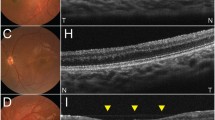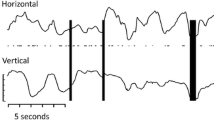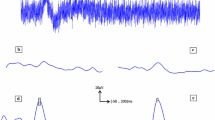Abstract
Background
Optic nerve hypoplasia (ONH) is a congenital deficiency of retinal ganglion cells and their axons that form the optic nerve. The condition is associated with visual deficits ranging from no light perception in severe cases, to vision within normal range in mild cases of ONH. We report here a case of mild ONH with normal vision and with visual symptoms relating to a spontaneously occurring Pulfrich effect.
Methods
A twelve-year-old girl presented with typical visual symptoms (veering to the right when walking, bumping into things) associated with the spontaneous Pulfrich effect. When asked to follow a bob suspended from a simple rigid pendulum swinging in the frontal plane, a clockwise ellipse was reported, indicative of a left-sided Pulfrich effect. This effect was neutralised by an 85% transmission ophthalmic tint placed before the right eye. The inter-ocular latency difference responsible for the illusion was calculated to be 0.88 ± 0.55 ms.
Results
Fundus biometry showed an asymmetry in R and L optic nerve dimensions, the left being smaller than the right. Vision was normal in each eye, as were visual fields, colour vision and stereopsis. The affected eye showed normal flash and pattern VEPs and ERGs, except for a borderline reduction of the pattern ERG (PERG) to very small checks.
Conclusions
A case of mild ONH with normal visual function in each eye resulted in a small inter-ocular delay associated with errors in visual perception consistent with a spontaneous Pulfrich effect. Wearing a pair of glasses with the right lens tinted eliminated these difficulties.


Similar content being viewed by others
References
Wertenbaker C, Goodman I (1985) Unusual visual symptoms. Surv Ophthalmol 29:297–299
Heron G, Dutton GN (1989) Pulfrich phenomenon and its alleviation with a neutral density filter. Br J Ophthalmol 73:1004–1008
Heron G, McQuaid M, Morris E (1995) The Pulfrich effect in optometric practice. Ophthal Physiol Opt 15:425–429
Lit A (1949) The magnitude of the Pulfrich stereophenomenon as a function of binocular differences of intensity at various levels of illumination. Am J Psychol 62:159–181
Odom JV, Bach M, Barber C, Brigell M, Marmor MF, Tormene AP, Holder GE, Vaegan (2004) Visual evoked potentials standard. Doc Ophthalmol 108:115–123
Holder GE, Brigell MG, Hawlina M, Meigen T, Vaegan, Bach M (2007) ISCEV standard for clinical pattern electroretinography-2007 update. Doc Ophthalmol 114:111–116
Wali N, Leguire LE (1992). The photopic hill: A new phenomenon of the light adapted electroretinogram. Documenta Ophthalmologica 80:335–342
Billock VA, Vingrys AJ, King-Smith PE (1994) Opponent-colour detection threshold asymmetries may result from reduction of ganglion cell subpopulations. Visual Neuroscience 11:99–109
Pickford RW, Lakowski R (1960) The Pickford-Nicolson anomaloscope. Brit J Physiol Opt 17:131–150
Adams AJ, Schefrin B, Huie K (1987) New clinical color threshold test for eye disease. Am J Optom Physiol Opt 64:29–37
Lakowski R (1972) The Pickford-Nicolson anomaloscope as a test for acquired dyschromatopsias. Mod Prob Ophthalmol 11:25–33
Borchert M, McCulloch D, Rother C, Stout AU (1995) Clinical assessment, optic disk measurements, and Visual-Evoked Potential in optic nerve hypoplasia. Am J Ophthalmol 120:605–612
Alvarez E, Wakakura M, Khan Z, Dutton GN (1988) The disc-macula to disc diameter ratio: a new test for confirming optic nerve hypoplasia in young children. J Ped Ophthal Strab 25:151–154
Barr DB, Weir CR, Purdie AT (1999) An appraisal of the disc-macula distance to disc ratio in the assessment of optic disc size. Ophthal Physiol Opt 19:365–375
Bach M, Unsoeld AS, Philippin H, Staubach F, Maier P, Walter HS, Bomer TG, Funk J (2006) Pattern ERG as early risk indicator in ocular hypertension—a long-term prospective study. Invest Ophthalmol Vis Sci 47:4888–4894
Ueno S, Kondo M, Niwa Y, Terasaki H, Miyake Y (2004) Luminance dependence of neural components that underlies the primate photopic electroretinogram. Invest Ophthalmol and Vis Sci 45:1033–1040
Heron G, McCulloch DL, Dutton GN (2002) Visual latency in the spontaneous Pulfrich effect. Graefes Arch Clin Exp Ophthalmol 240:644–649
Holder GE (2001) Pattern electroretinography (PERG) and an integrated approach to visual pathway diagnosis. Prog Retin Eye Res 20:531–561
Grimsdale H (1925) A note on Pulfrich’s phenomenon with a suggestion on the possible clinical importance. Br J Ophthalmol 9:36–65
Heron G, Thompson KJ, Dutton GN (2007) The symptomatic Pulfrich phenomenon can be successfully managed with a coloured lens in front of the good eye. Eye (in press: Epub 2006 Jun 9 ahead of print)
Breyer A, Jiang X, Rütsche A, Bieri H, Oexl T, Mojon DS (2006) Influence of the Pulfrich phenomenom on driving performance. Graefes Arch Clin Exp Ophthalmol 244:1551–1561
Speigler JB (1986) Apparent path of a Pulfrich target as a function of the slope of its plane of motion: a theoretical note. Am J Optom Physiol Opt 63:209–216
Author information
Authors and Affiliations
Corresponding author
Additional information
The authors have no financial interest in this study, have control over the data presented and agree to allow Graefe’s Archive for Clinical and Experimental Ophthalmology to review this data if requested.
Rights and permissions
About this article
Cite this article
Heron, G., Dutton, G.N., McCulloch, D.L. et al. Pulfrich’s phenomenon in optic nerve hypoplasia. Graefes Arch Clin Exp Ophthalmol 246, 429–434 (2008). https://doi.org/10.1007/s00417-007-0721-3
Received:
Revised:
Accepted:
Published:
Issue Date:
DOI: https://doi.org/10.1007/s00417-007-0721-3




